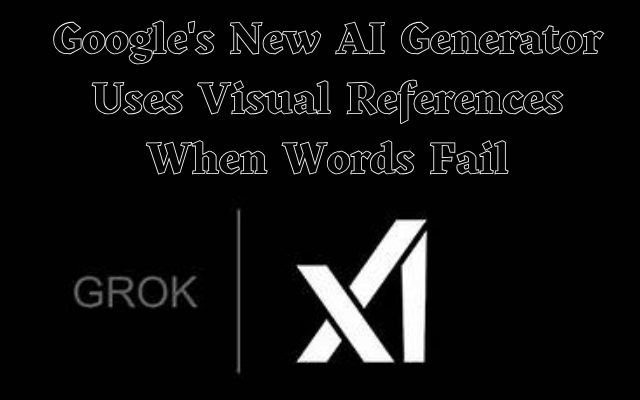Google’s New AI Generator Uses Visual References When Words Fail
Discover how Google's new AI generator uses visual references to improve communication when words fall short, making AI smarter and clearer.

By the end of 2024, X (formerly Twitter) will make Grok AI free for everyone. Grok gives answers without strong safety measures, which can be risky. While Grok focuses on openness, Google’s new AI generator uses visual cues when words fail, showing a safer and more helpful approach to AI. These two methods highlight the issue of balancing freedom and safety in AI technology.
Grok AI: Open, but Risky
AI tools often block certain questions to avoid giving harmful or unethical answers. For example, bots like OpenAI’s ChatGPT or Anthropic’s Claude sometimes refuse to answer, assuming bad intentions. To get around this, users often have to rephrase their questions—a process that can be frustrating and time-consuming.
Elon Musk’s Grok AI, now free for everyone, takes a different path. It’s designed to give straightforward answers without as many safety restrictions. Whether you want an unfiltered opinion, a playful roast or thoughts on conspiracy theories, Grok doesn’t shy away from responding. While it sometimes adds warnings, it still tries to answer most questions directly.
For many, this open approach feels refreshing. Grok doesn’t block your curiosity or assume it knows what’s best for you. Unlike other bots, it’s more willing to engage in sensitive or controversial topics, which some users find exciting.
But this freedom has risks. Grok has fewer safety rules, so it sometimes gives harmful or troubling answers. This makes people wonder if being so open is safe. Should AI share dangerous or sensitive information?
While programs such as Google’s New AI Generator use visual references. When Words Fail showcases innovation, Grok’s approach emphasizes perils of putting openness ahead of safety. Balancing freedom & ethical responsibility is a dilemma that the AI world must tackle.
Grok AI’s Image Generation: Convenient but Risky
Most AI chatbots are trained on information that’s already outdated, often one or two years old. This becomes a problem when you ask them about recent developments, like new smart home technologies or the latest laws. Tools like Google’s Gemini or Meta’s Llama often give outdated or even incorrect responses because their training data isn’t current.
What sets Grok apart is its lack of heavy restrictions. While other AI art tools like MidJourney tend to sanitize user inputs or reject certain requests, Grok doesn’t treat users like children. It’s not as advanced or creative as some dedicated AI art tools, but it’s far less restrictive.
However, this freedom comes with significant risks. Grok’s image generation:
- Doesn’t enforce ethical use of AI-generated art.
- May reuse copyrighted material without warning, potentially causing legal trouble for users.
- Allows misuse of others’ likenesses to create nearly any image.
While this openness can be fun for harmless creativity, it’s easy to see how Grok’s image generation could be abused. Bad actors could use it to create fake images or videos for cyberbullying, spreading false information, or even political propaganda.
Convenience and freedom Grok offers are impressive, but the lack of content moderation makes it a double-edged sword. Without safeguards, its potential for harm could outweigh its benefits.
- My Favorite App for Tracking Expenses: The Key to Saving More
- Why Your Laptop Battery Doesn’t Last as Long as Advertised
- Turn Any Document Into a Stunning Presentation with AI Trick
Grok AI Learns from Tweets: A Strength and a Risk
Most AI chatbots are trained on information that’s already outdated, often one or two years old. This becomes a problem when you ask them about recent developments, like new smart home technologies or the latest laws. Tools like Google’s Gemini or Meta’s Llama often give outdated or even incorrect responses because their training data isn’t current.
Grok AI tries to fix this by learning from Tweets. To see how well it works, I asked Grok about recent events and niche topics. I tested its knowledge on everything from the latest doorbell camera technology to updates on South Korea’s martial law news. Surprisingly, Grok performed better than most bots, providing accurate and up-to-date answers. It didn’t stumble on any of my questions, which was impressive.
However, there’s a catch. Training an AI on Tweets comes with risks. Twitter (now X) is full of misinformation, scams and bots. This raises concerns about how reliable Grok’s answers really are. Can it filter out biased or false information, or will its training data make it unreliable at times?
If you are unhappy with Grok utilizing your articles for training, you can opt out. Despite these concerns, Grok stands out. Unlike many other AI tools, it seems unique, pushing boundaries and questioning how AI may function.
It is up to you to decide whether this is an innovative or dangerous strategy. While Grok’s capacity to stay current is exciting, users should keep in mind that it is based on a platform that may contain disinformation.



